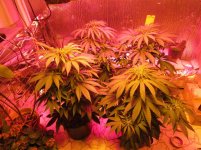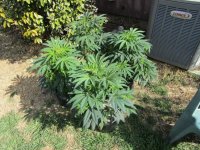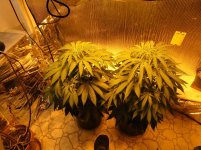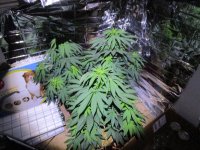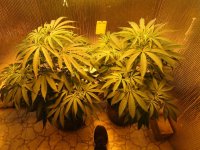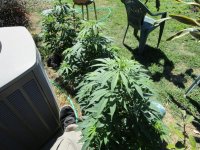This is an outdoor thread so will focus mostly on outdoor growing. Here, 2 plants going out on the first day to acclimate to the Sun. The photoperiod will switch from 16 hrs indoor to 12 hr outdoor. I'm using a 400HPS to add to the outdoor light until I can get a full 12 hrs of sunlight a day. The nights are still cold and so I will move them in the barn at night and back out in the Sun. Just to know here are the other indoor plants. 
-
ICMag with help from Phlizon, Landrace Warden and The Vault is running a NEW contest for Christmas! You can check it here. Prizes are: full spectrum led light, seeds & forum premium access. Come join in!
You are using an out of date browser. It may not display this or other websites correctly.
You should upgrade or use an alternative browser.
You should upgrade or use an alternative browser.
Plant seeds indoors for 2022 outdoors.
- Thread starter Creeperpark
- Start date
What's your latitude Creep? It seems like moving plants that big outside from 24 hour light would trigger them to flower, even seedlings. Are you planning on a spring harvest? One benefit to starting this early is that you get to pre sex and remove the males. Even starting seedlings now most of them should sex in May and June. I usually start in mid March because it's so cold and wet.
What's your latitude Creep? It seems like moving plants that big outside from 24 hour light would trigger them to flower, even seedlings. Are you planning on a spring harvest? One benefit to starting this early is that you get to pre sex and remove the males. Even starting seedlings now most of them should sex in May and June. I usually start in mid March because it's so cold and wet.
Rev you make some good points. I never grow on a 24 hr cycle I always let my plant sleep. Spring Flowers Friend! Flowering both gardens now before it gets too hot with long days. I have 5 females out of 6 plants, so I'm going to run with them for the fun of it.
I see, 16 hours of light down to 12. I've experimented with 24 constant and various night regimes. Didn't see any difference in plant growth except I saved a bit on my power bill with the night cycle. I think rooting clones might actually benefit from 24 on, probably from the heat. The main benefit from 24 on was I didn't have to worry about the screw ups that can occur with timers. Might be benefits to acclimating plants for outdoors with longer night periods.
In my area, now that daylight is at 11 hours, they probably don't need that extra hour of light from artificial lighting. Of course two weeks ago was different. I worry about mixing indoor and outdoor lighting as far as confusing the plant into turning hermie but it's probably not a big deal. The benefits of supplemental lighting this time of year from heat and the low light intensity from winter sun probably outweigh any potential harm. 11 hours of light might help convince the plants to stay in flowering longer, less likely to reveg, but I doubt you need to worry about it. I've found plants that fully enter flowering in February and early March don't start to revert until mid to late May. As long as the strains aren't equatorial, contain a good amount of Afghan or hemp genetics, they should be solid. Won't get the big harvest and super dense flowers you get from a fall harvest but it should turn out great. Mold will probably be the biggest problem, April showers bring May botrytis flowers..
In my area, now that daylight is at 11 hours, they probably don't need that extra hour of light from artificial lighting. Of course two weeks ago was different. I worry about mixing indoor and outdoor lighting as far as confusing the plant into turning hermie but it's probably not a big deal. The benefits of supplemental lighting this time of year from heat and the low light intensity from winter sun probably outweigh any potential harm. 11 hours of light might help convince the plants to stay in flowering longer, less likely to reveg, but I doubt you need to worry about it. I've found plants that fully enter flowering in February and early March don't start to revert until mid to late May. As long as the strains aren't equatorial, contain a good amount of Afghan or hemp genetics, they should be solid. Won't get the big harvest and super dense flowers you get from a fall harvest but it should turn out great. Mold will probably be the biggest problem, April showers bring May botrytis flowers..
These plants are in the outdoors now and will finish outdoors in 60 to 75 days on a 12/12 photoperiod. I will maintain a 12/12 using a 400-watt HPS light on cloudy days and when the days are too short. The light is off most of the time and is only used as a backup to maintain the 12 hr flowering photoperiod. When the outdoor photoperiod is between 11 and 12 on, I will just leave them outdoors 24 hrs a day. Right now I have to use the light for 4 hours of daylight to get the plant 12 hrs total. These plants are getting 320 ppm feeding with discharge, on every watering. 
Attachments
Rodehazrd
Well-known member
Hey creeper park I find the use of an organic core most interesting. Is there a reason not to have the whole container bio active? I use several methods to increase bacteria and fungi but never saw evidence that added ions hurt the growth of either.?
I use can04 through the stretch and add some mkp first weeks of flowering. Am I hurting my soil food web?
I use can04 through the stretch and add some mkp first weeks of flowering. Am I hurting my soil food web?
Hey creeper park I find the use of an organic core most interesting. Is there a reason not to have the whole container bio active? I use several methods to increase bacteria and fungi but never saw evidence that added ions hurt the growth of either.?
I use can04 through the stretch and add some mkp first weeks of flowering. Am I hurting my soil food web?
For negative and positive to have an attraction, you need both polarities. The core works in unison with the soil-less mix almost as equals even though the ratio is not exact. I have used the organic core as the delivery system and kept the soil-less mix as it is and had super results. This is basically an experiment on the technic above adding clay to the soil-less but keeping the core unchanged. There are so many different variables using many ratios, which are still unknown.
40degsouth
Well-known member
Hey everyone, l hope you’re all well.
l’ve been enjoying the conversation and liking the way it’s evolving and although I don’t know anything about soilless mixes l thought I’d chime in with a couple of additives that can help with the cation and anion exchanges (positive and negative ions of the different fertilisers being used) and their ability to reduce overall costs and applications.
Zeolite is something that’s not talked about enough, it holds onto both cations, anions and water and gives them up freely and never stop working in the soil.
Leonardite is a water soluble humate and although it’s a soil conditioner, not a fertiliser, it brings large amounts of carbon to the party which also has the ability to hold both cations and anions and powers the nitrate fixing microbes.
Lastly there’s biochar which contains huge amounts of carbon. The carbon molecule has the largest surface area of any other, so it’s got a lot of exchange sites for holding onto nutrients and habitat for microbes.
The zeolite and char can be added to the soil in any amount without detrimental effects because they’re inert but l think if you’re going to try the leonardite it’s probably best to ph the solution or maybe use it sparingly in the feedings.
Hope this helps,
Cheers,
40.
l’ve been enjoying the conversation and liking the way it’s evolving and although I don’t know anything about soilless mixes l thought I’d chime in with a couple of additives that can help with the cation and anion exchanges (positive and negative ions of the different fertilisers being used) and their ability to reduce overall costs and applications.
Zeolite is something that’s not talked about enough, it holds onto both cations, anions and water and gives them up freely and never stop working in the soil.
Leonardite is a water soluble humate and although it’s a soil conditioner, not a fertiliser, it brings large amounts of carbon to the party which also has the ability to hold both cations and anions and powers the nitrate fixing microbes.
Lastly there’s biochar which contains huge amounts of carbon. The carbon molecule has the largest surface area of any other, so it’s got a lot of exchange sites for holding onto nutrients and habitat for microbes.
The zeolite and char can be added to the soil in any amount without detrimental effects because they’re inert but l think if you’re going to try the leonardite it’s probably best to ph the solution or maybe use it sparingly in the feedings.
Hope this helps,
Cheers,
40.
Hey everyone, l hope you’re all well.
l’ve been enjoying the conversation and liking the way it’s evolving and although I don’t know anything about soilless mixes l thought I’d chime in with a couple of additives that can help with the cation and anion exchanges (positive and negative ions of the different fertilisers being used) and their ability to reduce overall costs and applications.
Zeolite is something that’s not talked about enough, it holds onto both cations, anions and water and gives them up freely and never stop working in the soil.
Leonardite is a water soluble humate and although it’s a soil conditioner, not a fertiliser, it brings large amounts of carbon to the party which also has the ability to hold both cations and anions and powers the nitrate fixing microbes.
Lastly there’s biochar which contains huge amounts of carbon. The carbon molecule has the largest surface area of any other, so it’s got a lot of exchange sites for holding onto nutrients and habitat for microbes.
Hope this helps,
Cheers,
40.
Hell yea that helps 40! Thank you for the valuable information! There are so many different variables for boosting the CEC. Biochar, Zeolite, and Leonardite could be on the future list to work with.
40degsouth
Well-known member
I’m really happy that’s helpful Creeperpark. It’s difficult to know what information to post up sometimes.
When experimental citrus growers started using zeolite, in large pots, it reduced their fertiliser costs by more than half because of it’s ability to hold onto nutrients, so of course fertiliser companies will never talk about it. When you think about it the initial cost of the zeolite far outweighs the future cost of fertiliser, assuming you intend to keep and re-use the soil of course.
The Cation Exchange Capacity is really important in the soil and as we know it’s just a way of describing the soil’s ability to hold onto nutrients. The Electrical Conductivity, or EC, works in conjunction with the CEC and describes the soil’s ability give up the nutrients it’s holding onto, as well as the amount of salts and overall soil health, among other things and there are meters that measure both.
l’ve been taking about the value of adding clay to soils for a very long time. The way I do it is to dig it up, put it in a bucket, with water, leave it for a day or three, mix it up and water it on. Steve Soloman stated that you can’t have humas without clay, which l found very interesting.
There’s also a clay additive, you can buy, called Bentonite that comes in a powdered form but when l researched it l remember cheap cat litter, the non-clumping type, was basically bentonite and cost next to nothing as compared to the actual soil additive.
Microbeman’s my absolute hero and well worth checking out if you haven’t already.
Cheers,
40.
When experimental citrus growers started using zeolite, in large pots, it reduced their fertiliser costs by more than half because of it’s ability to hold onto nutrients, so of course fertiliser companies will never talk about it. When you think about it the initial cost of the zeolite far outweighs the future cost of fertiliser, assuming you intend to keep and re-use the soil of course.
The Cation Exchange Capacity is really important in the soil and as we know it’s just a way of describing the soil’s ability to hold onto nutrients. The Electrical Conductivity, or EC, works in conjunction with the CEC and describes the soil’s ability give up the nutrients it’s holding onto, as well as the amount of salts and overall soil health, among other things and there are meters that measure both.
l’ve been taking about the value of adding clay to soils for a very long time. The way I do it is to dig it up, put it in a bucket, with water, leave it for a day or three, mix it up and water it on. Steve Soloman stated that you can’t have humas without clay, which l found very interesting.
There’s also a clay additive, you can buy, called Bentonite that comes in a powdered form but when l researched it l remember cheap cat litter, the non-clumping type, was basically bentonite and cost next to nothing as compared to the actual soil additive.
Microbeman’s my absolute hero and well worth checking out if you haven’t already.
Cheers,
40.
Last edited:
I’m really happy that’s helpful Creeperpark. It’s difficult to know what information to post up sometimes.
When experimental citrus growers started using zeolite, in large pots, it reduced their fertiliser costs by more than half because of it’s ability to hold onto nutrients, so of course fertiliser companies will never talk about it. When you think about it the initial cost of the zeolite far outweighs the future cost of fertiliser, assuming you intend to keep and re-use the soil of course.
The Cation Exchange Capacity is really important in the soil and as we know it’s just a way of describing the soil’s ability to hold onto nutrients. The Electrical Conductivity, or EC, works in conjunction with the CEC and describes the soil’s ability give up the nutrients it’s holding onto, as well as the amount of salts and overall soil health, among other things and there are meters that measure both.
l’ve been taking about the value of adding clay to soils for a very long time. The way I do it is to dig it up, put it in a bucket, with water, leave it for a day or three, mix it up and water it on. Steve Soloman stated that you can’t have humas without clay, which l found very interesting.
There’s also a clay additive, you can buy, called Bentonite that comes in a powdered form but when l researched it l remember cheap cat litter, the non-clumping type, was basically bentonite and cost next to nothing as compared to the actual soil additive.
Microbeman’s my absolute hero and well worth checking out if you haven’t already.
Cheers,
40.
Thank you for opening doors 40, I appreciate you, Friend.
Here's 3 days later.
The outdoor plants were having problems getting acclimated to the strong Sunshine. I got a little leaf burn on a few lower leaves on one plant. When I noticed the plants having a hard time with the Sun's heat, I moved them into more filtered Sunlight. I added hay mulch to the outdoor pots to help with the heat and I block the Sun from hitting the pots. .
The 3 outdoor plants are sleeping in the barn. All these plants are getting only 160 ppm of fertilizer with every watering. Working off the feed chart:
4 ml micro
1 ml of grow
5 ml of bloom, is added to (2 1/2) to 3 gallons of fortified rainwater. ( Rain with 126 ppm of cal-mag)
The outdoor plants were having problems getting acclimated to the strong Sunshine. I got a little leaf burn on a few lower leaves on one plant. When I noticed the plants having a hard time with the Sun's heat, I moved them into more filtered Sunlight. I added hay mulch to the outdoor pots to help with the heat and I block the Sun from hitting the pots. .
The 3 outdoor plants are sleeping in the barn. All these plants are getting only 160 ppm of fertilizer with every watering. Working off the feed chart:
4 ml micro
1 ml of grow
5 ml of bloom, is added to (2 1/2) to 3 gallons of fortified rainwater. ( Rain with 126 ppm of cal-mag)
Attachments
40degsouth
Well-known member
 What a lovely thing to say Creeperpark, you’ve made my day.
What a lovely thing to say Creeperpark, you’ve made my day. Thankyou.
I had a big cool down and had to return the plants indoors for 2 days. That's the nice thing about having outdoor plants in containers, you can move indoors if a frost or freeze happens. These plants seem like they're happy because of the previous warm weather. Gardening is one day at a time. 
Attachments
44:86N
Active member
Those fan leaves! Super nice looking plants, Creeper.
The Friesland are moving along. About half have good vigor, and the others are taking a little more time. Everyone got potted up about 3 weeks ago, and the vigorous growers all had great roots:

Cuttings have been taken, and the seed plants have just been moved to the flowering room, under a 600 watt hps. It has taken them a while to size up, but the temps in the greenhouse have been running on the low side, and the sun is finally having some real influence up here. Here they are a day or two prior to moving, under their supplemental led:

I will let you know how the cuttings turn out and what the male/female ratio is.
The Friesland are moving along. About half have good vigor, and the others are taking a little more time. Everyone got potted up about 3 weeks ago, and the vigorous growers all had great roots:
Cuttings have been taken, and the seed plants have just been moved to the flowering room, under a 600 watt hps. It has taken them a while to size up, but the temps in the greenhouse have been running on the low side, and the sun is finally having some real influence up here. Here they are a day or two prior to moving, under their supplemental led:
I will let you know how the cuttings turn out and what the male/female ratio is.
Those fan leaves! Super nice looking plants, Creeper.
The Friesland are moving along. About half have good vigor, and the others are taking a little more time. Everyone got potted up about 3 weeks ago, and the vigorous growers all had great roots:
filedata/fetch?id=18094598&d=1646877501
Cuttings have been taken, and the seed plants have just been moved to the flowering room, under a 600 watt hps. It has taken them a while to size up, but the temps in the greenhouse have been running on the low side, and the sun is finally having some real influence up here. Here they are a day or two prior to moving, under their supplemental led:
filedata/fetch?id=18094599&d=1646877522
I will let you know how the cuttings turn out and what the male/female ratio is.
Thanks, Friend. The Sun is getting close enough for the plants to thrive again. I'm keeping my photoperiod on 12/12 for all my plants, indoors and out, to flower before it gets too hot. I already have to buffer the heat away from the pots or it will cook the roots with a shade clothe. Hey, 44 are you using natural outdoor photoperiod?
44:86N
Active member
Thanks, Friend. The Sun is getting close enough for the plants to thrive again. I'm keeping my photoperiod on 12/12 for all my plants, indoors and out, to flower before it gets too hot. I already have to buffer the heat away from the pots or it will cook the roots with a shade clothe. Hey, 44 are you using natural outdoor photoperiod?.
I have had the plants under 24 hours of light, and will keep the clones under that regime as well until early May, when I will begin to slowly step it down so as not to shock the clones when they come out into the full sun. Our official "frost date" is May 25, with sneakers possible through the first week of June.
Kind of cool that you get such a jump on the season. Have you ever tried using white pots?
Up here I will do the reverse, which is start a long flowering plant late, so I can move it in when it gets too cold. I have gotten some nice harvests off of plants that spent time growing outdoors, and then finished indoors.
These 3 soil-less plants are outdoor plants now, living in early spring under a 12/12 photoperiod. They are at the beginning of flowering and will remain in flowering until they finish. I move them in and out of the barn to maintain a 12 hr. flowering period. I will leave them out when the daily photoperiod equals the flowering hrs. These are Sun grown plants from this point on and started indoors for this reason. I love harvesting Spring Flowers! By the time these plants are finished, it will be close to June when most people's plants are in still in veg. 


